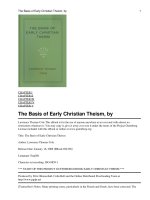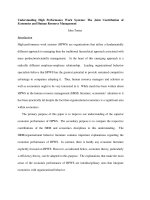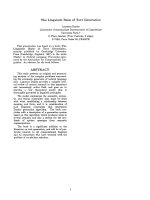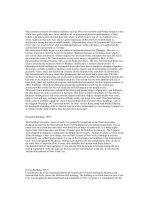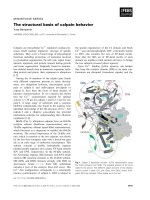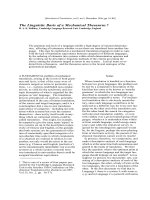integrated buildings - the systems basis of architecture
Bạn đang xem bản rút gọn của tài liệu. Xem và tải ngay bản đầy đủ của tài liệu tại đây (26.64 MB, 495 trang )
JOHN WILEY & SONS, INC.
Integrated Buildings
THE SYSTEMS BASIS OF ARCHITECTURE
LEONARD R. BACHMANIntegrated Buildings
JOHN WILEY & SONS, INC.
Integrated Buildings
THE SYSTEMS BASIS OF ARCHITECTURE
LEONARD R. BACHMAN
This book is printed on acid-free paper.
o
Copyright © 2003 by John Wiley & Sons, Inc. All rights reserved.
Photographs by Leonard R. Bachman unless otherwise noted.
Published by John Wiley & Sons, Inc., Hoboken, New Jersey
Published simultaneously in Canada
No part of this publication may be reproduced, stored in a retrieval system, or transmitted in any
form or by any means, electronic, mechanical, photocopying, recording, scanning, or otherwise,
except as permitted under Section 107 or 108 of the 1976 United States Copyright Act, without either
the prior written permission of the Publisher, or authorization through payment of the appropriate
per-copy fee to the Copyright Clearance Center, Inc., 222 Rosewood Drive, Danvers, MA 01923, (978)
750-8400, fax (978) 750-4470, or on the web at www.copyright.com. Requests to the Publisher for
permission should be addressed to the Permissions Department, John Wiley & Sons, Inc., 111 River
Street, Hoboken, NJ 07030, (201) 748-6011, fax (201) 748-6008, e-mail:
Limit of Liability/Disclaimer of Warranty: While the publisher and author have used their best efforts
in preparing this book, they make no representations or warranties with respect to the accuracy or
completeness of the contents of this book and specifically disclaim any implied warranties of mer-
chantability or fitness for a particular purpose. No warranty may be created or extended by sales rep-
resentatives or written sales materials. The advice and strategies contained herein may not be suitable
for your situation. You should consult with a professional where appropriate. Neither the publisher
nor author shall be liable for any loss of profit or any other commercial damages, including but not
limited to special, incidental, consequential, or other damages.
For general information on our other products and services or for technical support, please contact
our Customer Care Department within the United States at (800) 762-2974, outside the United States
at (317) 572-3993 or fax (317) 572-4002.
Wiley also publishes its books in a variety of electronic formats. Some content that appears in print
may not be available in electronic books. For more information about Wiley products, visit our web
Library of Congress Cataloging-in-Publication Data:
Bachman, Leonard R.
Integrated buildings: the systems basis of architecture / Leonard R. Bachman
p. cm.
Includes bibliographical references and index.
ISBN 0-471-38827-0
1. Architecture and technology. 2. Architectural design — Case studies.
3. Architectural engineering. I. Title
NA2543.T43 B33 2003
729 — dc21 2002015346
Printed in the United States of America
10 9 8 7 6 5 4 3 2 1
site at www.wiley.com.
Preface vii
Acknowledgments ix
PART I: METHODS 1
Chapter 1: The Idea of Integration . . . . . . . . . . . . . . . . . . . . . . . . . . . . . 3
Hardware: integration among building systems; software: integration in the design
process; philosophical digression: integration and the progress of technology; frame-
work of discussion.
Chapter 2: The Systems Basis of Architecture . . . . . . . . . . . . . . . . . . . 17
Systems thinking; architectural systems; developments in systems architecture: precepts
and trends.
Chapter 3: Integrated Building Systems. . . . . . . . . . . . . . . . . . . . . . . . 32
Modes of integration: physical, visual, and performance; integrated systems: envelope,
structural, mechanical, interior, and site; integration potentials.
Chapter 4: The Architecture of Integration . . . . . . . . . . . . . . . . . . . . . 48
The example of the Pacific Museum of Flight; program: client, code, and other con-
straints; intention: architectural ambition; critical technical issues: inherent, contextual,
and intentional; the use of precedent; appropriate systems: structure, envelope, mechan-
ical, interior, and site; beneficial integrations.
PART II: CASE STUDIES 79
Building database; timeline. 80
Chapter 5: Laboratories . . . . . . . . . . . . . . . . . . . . . . . . . . . . . . . . . . . . 82
Typology overview; Richards Medical Research Building; Salk Institute for Biological
Studies; Schlumberger Research Laboratory; PA Technology Laboratory; Wallace Earth
Sciences Laboratory.
Chapter 6: Offices . . . . . . . . . . . . . . . . . . . . . . . . . . . . . . . . . . . . . . . 139
Typology overview; John Deere Headquarters; Willis Faber Dumas Insurance
Headquarters; Briarcliff House; Lockheed Building 157.
Contents
v
Chapter 7: Airport Terminals . . . . . . . . . . . . . . . . . . . . . . . . . . . . . . . 190
Typology overview; Dulles International; Stansted International; United Airlines
Terminal at O’Hare; Kansai International.
Chapter 8: Pavilions. . . . . . . . . . . . . . . . . . . . . . . . . . . . . . . . . . . . . . . . . 245
Typology overview; Munich Olympic Stadium; Insitut du Monde Arabe; Linz Design
Center; British Pavilion, Expo 92.
Chapter 9: Residential Architecture . . . . . . . . . . . . . . . . . . . . . . . . . . 299
Typology overview; The Eames House and Studio; Magney House; Experimental House
at Almere; Two-Family House at Pullach.
Chapter 10: High Tech Architecture . . . . . . . . . . . . . . . . . . . . . . . . . . 345
Typology overview; Centre Georges Pompidou; Sainsbury Centre for Visual Arts;
Lloyd’s of London; Hong Kong and Shanghai Bank.
Chapter 11: Green Architecture . . . . . . . . . . . . . . . . . . . . . . . . . . . . . 402
Typology overview; The Gregory Bateson Building; NMB Bank; Emerald People’s
Utility District Headquarters; Adam Joseph Lewis Center for Environmental Studies.
Bibliography 455
Index 475
vi
CONTENTS
he idea for this book originated at the University of
Houston, Gerald D. Hines College of Architecture. Our
technology faculty met in the spring of 1986 to discuss
course revisions and curriculum coordination. The press-
ing needs we saw at that time were twofold. First, our
research methods class needed to be reconfigured. Second,
we wanted to provide more opportunities for students to
assimilate technology course topics in the studio setting.
We settled on a new textbook, The Building Systems
Integration Handbook (Rush, et al., 1986), as the solution
to both problems.
The course remains a capstone technology class in the
college today. It is a case study seminar class of about 25
upper-level undergraduate students and a few graduates
who take the class as an elective. Anatomical studies are
made of the systems used in landmark buildings as if we
were in a biology laboratory. Students ponder over the
component systems, deduce how the design and the tech-
nology came to fit, and propose how that fit enables the
design’s architectural success. David Thaddeus, our struc-
tures curriculum leader, later joined the faculty at the
University of North Carolina at Charlotte and initiated a
similar course there. Meanwhile, a growing number of
integration courses are offered at architecture schools
around the world.
The inclusion of integrated systems design in our
increasingly complex and technically sophisticated archi-
tecture seems like an obvious idea. It seems so obvious, in
fact, that the counter-position of seeing integration as “just
another word for design” is worth pondering. Isn’t archi-
tecture already among the most inclusive of all disciplines?
Are architects not truly the “last of the Renaissance profes-
sionsals”? What is so new about integration that distin-
guishes it from what architects have always done?
The answer to these questions requires preliminary
inquiry. First, “What is integration?” and “How do archi-
tects manage it?” The answers are illustrated by a push-
pull dynamic. Integration is specifically concerned with
that aspect of architecture in which technology constantly
pushes design possibilities expansively while design assim-
ilation continuously pulls them inward toward a final
solution. As part of the design process, integration activi-
ty follows a path paved by the architect’s philosophy of
appropriate judgment. Technical requirements restrict the
subjective freedom of such judgments and set up a series
of integration challenges for the architect to solve. There is
nothing new about “integration” per se. It is not a stylistic
or comprehensive design approach, and the discussions in
this book are not a critique of present practice or a new
historical perspective. Integration is, however, an emer-
gent and increasingly critical focus of architectural design.
This book is about that emergence and focus.
First, the medium of architecture must be re-examined
if the increased scope of our architecture as well as the
complexity of its goals [are] to be expressed. Simplified
or superficially complex forms will not work. . . . Second,
the growing complexities of our functional problems
must be acknowledged.”
Robert Venturi, Complexity and Contradiction in Architecture
(1966, p. 19).
Focus on integration as a discipline arises from the
sudden injection and rapid advancement of technical sys-
tems since the Second World War. Change has since
occurred at a revolutionary pace, far outstripping the
advances of design accommodation and the technical edu-
cation of architects. And revolutionary change has never
been the mode of mainstream architectural thinking.
Creative risk taking for architects is usually confined to
elements of style, formal expression, and contextual rele-
vance. Experimental building systems are seldom selected
over proven ones (except for world’s fair pavilions, where
dramatic and usually temporary solutions are expected).
An example of risk-taking failure might be the early short-
Preface
T
vii
comings of “solar architecture” in achieving mainstream
status in the eyes of the profession or in the dreams of a
large public audience.
This book puts integration into what could be called
the mediating or middle ground between design and tech-
nology. The middle ground has previously fallen primari-
ly to a few works that chronicle the advent of building
technology. Peter Reyner Banham, James Marston Fitch,
and Martin Prawley were among the first to give integra-
tion issues a voice. David Guise, Carl Bovil, and Richard
Rush (et al.) are among later contributors. Buckminster
Fuller’s special contributions are covered in Chapter 2 of
this book. Along the way there have also been a number of
architect/engineers whose individual design work and
architectural collaborations qualify as purely integrative:
Luigi Nervi, Felix Candela, Frei Otto, and Peter Rice, to
mention some prominent individuals.
Integration as an independent topic came to the fore-
ground in 1986 when Richard Rush and an impressive
team of investigators researched and wrote the Building
Systems Integration Handbook (Rush, 1986). The BSI
Handbook was still in popular use in its sixth unrevised
printing. This present text will, it is hoped, find an audi-
ence with continuing interest in integration topics. The
author gratefully acknowledges a debt to those who pio-
neered the field.
This present textbook assumes that the reader has some
preparation in architectural design,technology, and history.
It is not a primer,and there is no easy substitute for the back-
ground that this book presumes. The novice will do well to
use a good number of the cited references as companion
reading. The conceptual overviews offered in this text are
probably not adequate for the beginning student.
Methods of integration make up Part I of this book.
This part is broken into four chapter-length topics. The
first of these presents a rationale and overview of integra-
tion topics. Chapter 2 describes “Systems Thinking” from
the time of the Crystal Palace forward. Chapter 3 looks at
different modes of integration activity and overviews the
integration potential of building systems. The final chap-
ter on methods, Chapter 4, presents an analytical model
for tracing integration through any work of architecture,
as well as an expanded case study of Ibsen Nelsen’s design
for the Pacific Museum of Flight as an example analysis.
The sole intent of methods section is to illustrate a
procedure for analyzing building integration. No attempt
is made to imitate the holistic complexity of design; the
integration paradigm in this Part necessarily portrays
design activities in a simplified step-by-step fashion. The
value of this limited perspective is, of course, that it allows
isolation of topics so that they can be digested piece by
piece. Analytical exercise of the paradigm should ulti-
mately lead to a greater ability to define and synthesize
one’s own design ambitions.
The case studies selected for inclusion in Part II illus-
trate how systems technology and integration thinking have
been championed and advanced. The grouping of the
example buildings by type and chronology provides a
matrix of works that are widely accepted as significant
buildings. Critical evaluation of these buildings is not vital-
ly important in this text; the buildings were selected prima-
rily for ease of unfolding their integration lessons.
Nonetheless, most of the buildings chosen are well recog-
nized in the mainstream and easily accessible through
numerous publications. It is hoped that their inclusion here
helps to illustrate integration in clear and relevant ways.
Please send feedback to the author’s attention at:
L
EONARD R. BACHMAN
University of Houston
College of Architecture 4431
Houston, Texas 77204-4431
or
viii
PREFACE
First comes love, then comes courage,
then comes truth.
Richard Rush, February 21, 2001, in an
E-mail of encouragement
colleague and mentor, Bruce Webb, suggested that a
meta-book, or at least a story about how this book
unfolded, might be worthwhile. It struck me later that per-
haps something of that account could serve as an acknowl-
edgment of the many people and institutions that
contributed to its cause.
First I want to recognize the University of Houston
College of Architecture and students who participated
directly by producing material for the book. Aside from
course participation, there were some special contribu-
tions. Rich Kaul completed the lion’s share of the graphics
and did considerable work on the manuscript for work-
shop credit. He also generated the PA Technology
Laboratory case study in Chapter 5. Andrew Lewis worked
on the graphics for no reason other than his sincere inter-
est in the topic. Both Rich and Andy are graduate students.
Travis Hughs, a fifth-year senior in our undergraduate
program, constructed the 3-D CAD models used as illus-
trations of some buildings.
My longtime friend and grandly popular peer, David
Thaddeus, was first to suggest publication of the course-
work and case studies being developed in the Building
Systems Integration class. In late June of 1999 he and I met
John Wiley & Sons editor Amanda Miller at the American
Collegiate Schools of Architecture (ACSA) conference in
Montreal, and the three of us discussed a book proposal.
David had just joined the faculty at the University of North
Carolina–Charlotte, however, and ongoing demands of
moving his career and family there from Houston eventu-
ally kept him from collaborating. David worked on the
formative concepts and some of the case study material. He
will see his own hand in many parts of this book.
Richard Rush endorsed the notion of a successor to
the Building Systems Integration Handbook and provided
mounds of wisdom and support for this project. Several
members of the Society of Building Science Educators
(SBSE) offered direction and comments on the proposal.
Other members contributed photographs in response to a
single posting on the (SBSE) server. G. Z. Brown mentored
early ideas at the Montreal ACSA conference. Murray
Milne was there with encouragement and direction and
also helped plan a California case study expedition. John
Reynolds provided the workings of the Emerald Peoples
Utility District case study (Chapter 11). As always, the best
advice provides some of the highlights of this book, but
the author is to blame for the remaining blemishes. SBSE
can be found at htt
p://www.sbse.org. Alternately, send
SBSE inquiries to Walter Grondzik / Department of
Architecture, University of Oregon / School of
Architecture / Florida A&M University / Tallahassee, FL
32307-4200.
In December 2000, I received an invitation from Chris
Luebkeman on behalf of Ove Arup & Partners to research
eight of the case study buildings that had passed through
their offices. The offer included mention of searching
Arup archives, so I quickly booked a flight to London. An
internal grant from the University of Houston’s Office of
Sponsored Programs and support from the UH College of
Architecture actually got me off the ground. The eight
busy days I spent in southeast England were vital to every-
thing in this book.
During the London stay, Luebkeman and colleagues
were profoundly generous with their time and resources.
Maureen Gil arranged building tours; Pauline Shirley
opened the Arup photo library. Robert Lang and Jo
A
Acknowledgments
ix
DaSilva granted interviews and offered insights on how
integration happens in an Arup project. Peter Warburton
of Arup Associates spent a day of his time with me at
Briarcliff House, introduced me to Briarcliff teammate
Terry Raggett, and also toured me around his own office
group. Everyone at both Arup organizations was an
intrepid listener, and I will never overcome the fascination
I felt while talking with them. It inspires one to say things
worth listening to.
John Jacobson patiently ushered me through the con-
fines and corners of Lloyd’s of London, as did Ken
Osborne at Schlumberger in Cambridge. Both took an
obvious and possessive pride in their respective buildings
and also went to great lengths to make sure I didn’t miss
any of the high points. Some of their firsthand knowledge
may be apparent in the case studies. An intimate working
relationship with an architecturally successful building is a
profound matter.
Everywhere, the book made friends. Queries and
requests for information always seemed to broaden the
alliances. Thanks go to Kay Poludniowski at the Sainsbury
Center for Visual Arts and to several people at Deere &
Company for sending comments and photographs. Burns
and McDonald Engineering even mailed its 50th
Anniversary book publication and put me in touch with
associates who had worked with Eero Saarinen on the
Deere Headquarters and Dulles Airport.
On the home front, many thanks to my dean, Joe
Mashburn, for the resources and support of the University
of Houston College of Architecture.Kudos to the entire staff
at the William R. Jenkins Art and Architecture Library (you
can have your books back now), starting with our head
librarian, Margaret Culbertson. Bruce Webb reviewed sev-
eral draft versions of the manuscript. Rives Taylor, who
already splits time between our college and duty as campus
architect for M. D. Anderson Hospital, still had the patience
to read and comment on drafts. Some of the visiting lectur-
ers at the college also contributed important ideas: Bernard
Plattner from the Renzo Piano Workshop and Alistair
McGregor from the San Francisco office of Ove Arup &
Partners, to name just a couple. Peter Wood, my former
dean now serving at Prairie View A&M, helped with forma-
tive ideas and recommended Daniel Willis’s Emerald City.
Portions of this book were written while visiting my
wife’s family, the Kellers, in Bulle, Switzerland, and their
parents’ house was the base camp for several case study
expeditions. The Kellers’ hospitality and encouragement
are with me still, not to mention my memories of the cof-
fee, wine, and seemingly continuous banquet at their live-
ly dinner table.
Finally, no book should ever be written without men-
tioning the people who suffered its tribulations in their
own daily lives. Fortunately, my friend, lover, and partner,
Christine, finished her master’s thesis and began her doc-
torate work through the same time frame of this book’s
story. Of course, the background research, the building vis-
its, and the obsessive stack of photographs were acquired
over several years and Christine was there for all that too.
She just finished one of many readings of yet another draft.
We have had a great deal to talk about these last few years—
whenever we looked up from our computers.
L
EONARD BACHMAN
x
ACKNOWLEDGMENTS
Integrated Buildings
Methods
iscussion about the architecture of integrated
buildings systems begins with a few basic ques-
tions. These fundamental questions underlie the
four “methods” chapters of Part I. The seven succeeding
chapters of Part II explore how these questions relate to
several works of architecture. Taken as a whole, then, this
book shows how case studies can be used to understand
the integration of building systems and how inquiry into
integration contributes to architectural success.
•
What are integrated buildings?
•
How does design for integration impact architectural
thinking?
•
Is integration the architect’s responsibility?
•
How does the notion of “building system” tie in with
the idea of “systems thinking”?
•
What benefits does integration provide?
Hardware: Integration Among
Building Systems
In theory, it is entirely possible to design and construct a
building made of totally independent components. The
separate pieces of such a building could be designed in iso-
lation, each part having an autonomous role to play.
Someone who proposes this idea may note that a beam is a
beam and a duct is a duct, after all, and there is no need to
confuse one for the other. For every function or role to be
performed in a building, there are a host of competing and
individualized products to choose from. As long as the final
assembly has already been worked out, the independent
pieces can fulfill their single-purpose roles simply by fitting
in place and not interfering with other pieces.
Most architects would quickly denounce this isolation-
ist approach to design. Where, they would ask, is the har-
mony, the beauty, or even the practicality in such an
CHAPTER 1 TOPICS
• Hardware: Integration Among Building Systems
• Software: Integration in the Design Process
• Philosophical Digression: Integration and the
Progress of Technology
• Framework of Discussion
3
The Idea of Integration
CHAPTER
1
absurdly fragmented method? Surely there is some sym-
pathy and order among the parts that lead to a compre-
hensive whole?
Architects are, in fact, inherently prone to take exactly
the opposite approach: Starting with carefully considered
ideas about the complete and constructed building, they
would then explore inward, working through intricate
relationships between all the parts and functions. But how
far does this concern for relationships go, and how inclu-
sive is the complete idea? Equally important, what sort of
thinking is required to comprehend and resolve all the
issues that arise in the process? This is where the topic and
discipline of integration fits in— providing an explicit
framework for selecting and combining building compo-
nents in purposeful and intentional ways.
Integration among the hardware components of
building systems is approached with three distinct goals:
Components have to share space, their arrangement has to
be aesthetically resolved, and at some level, they have to
work together or at least not defeat each other. These three
goals are physical, visual, and performance integration.
The following sections serve as a brief overview of how
these goals are attained.
PHYSICAL INTEGRATION
Building components have to fit. They share space and
volume in a building, and they connect in specific ways.
CAD drawing layers offer a useful way to think about how
complicated these networks of shared space and connect-
ed pieces can become. Superimposing structure and
HVAC (heating, ventilating, and air-conditioning) layers
provides an example: Are there problems where large
ducts pass under beams? Do the reflected ceiling plan and
furniture layouts put light fixtures where they belong?
Physical integration is fundamentally about how com-
ponents and systems share space, how they fit together. In
standard practice, for example, the floor-ceiling section of
many buildings is often subdivided into separate zones:
recessed lighting in the lowest zone, space for ducts next,
and then a zone for the depth of structure to support the
floor above. These segregated volumes prevent “interfer-
ence” between systems by providing adequate space for
each individually remote system. Meshing the systems
together, say, by running the ducts between light fixtures,
requires careful physical integration. Unifying the systems
by using the ceiling cavity as a return air plenum and
extracting return air through the light fixtures further
compresses the depth of physical space required. If the
structure consists of open web joists, trusses, or a space
frame, then it is possible that all three systems may be phys-
ically integrated into a single zone by carefully interspers-
ing ducts and light fixtures within the structure.
Connections between components and among sys-
tems in general constitute another aspect of physical inte-
gration. This is also where architectural details are
generated. The structural, thermal, and physical integrity
of the joints between different materials must be carefully
considered. How they meet is just as important as how
they are separated in space.
VISUAL INTEGRATION
Exposed and formally expressive components of a building
combine to create its image. This is true of the overall visu-
al idea of the building as well as of the character of rooms
and of individual elements, down to the smallest details.
The manner in which components share in a cumulative
image is decided through acts of visual integration. Color,
size, shape, and placement are common factors that can be
manipulated in order to achieve the desired effect, so
knowledge of the various components’ visual character is
essential to integrating them.
Visual harmony among the many parts of a building
and their agreement with the intended visual effects of
design often provide some opportunities for combining
technical requirements with aesthetic goals. Light fixtures,
air-conditioning, plumbing fixtures, and a host of other
elements are going to have a presence in the building any-
way. Ignoring them or trying to cover them with finishes
or decoration is futile. Technical criteria and the systems
that satisfy those functional demands require large shares
of the resources that go into a building. It follows that
architects should be able to select, configure, and deploy
building elements in ways that satisfy both visual and
functional objectives.
PERFORMANCE INTEGRATION
If physical integration is “shared space” and visual integra-
tion is “shared image,” then performance integration must
have something to do with shared functions. A load-bearing
wall, for example, is both envelope and structure, so it uni-
fies two functions into one element by replacing two
columns, a beam, and the exterior wall. This approach can
save cost and reduce complexity if it is appropriate to the
task at hand.
Performance integration is also served by meshing or
overlapping the functions of two components, even with-
out actually combining the pieces. This may be called
“shared mandates.” In a direct-gain passive solar heating
4
INTEGRATED BUILDINGS
system, for example, the floor of the sunlit space is sharing
in the thermal work of the envelope and the mechanical
heating system by providing thermal storage in its massive
heat capacity, which limits indoor temperature swings from
sunlit day to cold starry night. The envelope, structure, inte-
rior, and services are integrated by the shared thermal man-
date of maintaining comfortable temperatures.
INTEGRATING INTEGRATIONS:
LOUIS KAHN AND THE KIMBALL ART MUSEUM
The three modes of integration among systems are fre-
quently interwoven, so it is difficult and probably unnec-
essary to label every act of integration as either physical,
visual, or functional. The previous example of physical
integration in a floor-to-ceiling section among lighting,
ductwork, and structure also has important performance
benefits if the lighting fixtures are used as return air regis-
ters and the plenum is used as a return air path. In addi-
tion, combining the lighting and return air register func-
tions within the light fixtures simplifies the aesthetic of the
room’s ceiling. Most components of a building have phys-
ical, visual, and functional impacts; it is likely that one sort
of integration will involve other sorts.
For an example of how these forms of integration can
be combined, consider Louis Kahn’s design for the
Kimbell Art Museum. The synthesis of major systems is
characterized by unification and meshing among struc-
ture, envelope, services, and interior systems and is
embodied by the repeated use of an elegant concrete vault.
This one element is both structural support and envelope
enclosure. It also forms the interior space. Finally, by
virtue of its cycloid ceiling shape and skylit ridge, its func-
tions are meshed with the important services mandate of
lighting a space for artwork. The physical, visual, and per-
formance benefits are complete and convincing. The sys-
tems go beyond being minimally resolved; they are
synergistic to the point of being provocatively elegant. It
would be trivial to worry about their exact classification.
Figure 1.1 The Kimbell Art Museum, Louis Kahn, Fort Worth, Texas, 1966 to 1972. (Photo by Kristopher L. Liles.)
1 / The Idea of Integration
5
Software: Integration in the
Design Process
For integration issues to surpass the technology-for-its-
own-sake aspect and become celebrated in the design
process, they must transcend the nuts-and-bolts of hard-
ware integration and engage basic architectural ambition.
Resolving the physical, visual, and functional fit among
building systems is well and good. All buildings have to
achieve these basic levels of integration to some degree
before they can be built and occupied. It is also obvious that
different levels of integration among the systems is possible
and that a more highly integrated building is more likely to
enjoy better degrees of fit, image, and function. But
although these aspects contribute toward a better building,
they do not inherently satisfy the notion of architecture.
If building components are the hardware of integra-
tion, then design can be thought of as the software com-
plement. Design establishes the major architectural goals
of a project and then directs the process of attaining them.
The major goals can be described as the “architectural
intention,” and the management objectives as explorative
work toward its realization. Constant human evaluation
and the lens of subjective judgment prevent this from
becoming a literal sort of design computation. Like the “if
X then Y else Z” logic of software computation, however,
design is the comparable rational process by which archi-
tects manage the process.
UNIFYING ART AND SCIENCE
Design and technology, if considered separately, present
opposing priorities and agendas for architects.
Fortunately, their complementary nature allows for an
endless variety of starting places and any number of reso-
lutions. At one pole of thinking, for example, there is the
architect-as-artist, for whom technology is a means to the
higher ends of aesthetic and formal ideals. At the other
pole, for the architect-as-scientist, design is largely the
result of technically optimized and honestly expressed
solutions. Pure examples of these two poles would be hard
to find, however, because successful buildings usually have
some flavor of both aspects.
In modern architecture, the tensions between these
two poles, and their resolution, form an often-overlooked
aspect of successful buildings— overlooked despite how
they typify sound architectural practice. The marriage of
design ideals and technical innovation has become a
strong and prevailing generative device. This is especially
true since the postwar popularization of mechanical sys-
tems and the resulting complexity of interwoven building
systems.
Integration topics were born of these new complexi-
ties, and the struggle to incorporate large and expensive
new systems into buildings continued. But architects
would not be forever content to simply fit new systems
into old ways of thinking about buildings.
Accommodation of technology changed architectural
practice in more than an additive way. Physically incorpo-
rating the machines of industry and the magic of science
into the bowels of their buildings led many architects to
think of new and dynamic approaches to design. Here was
the opportunity of an expanded vocabulary of parts and
an almost magic essence of technical wizardry. In general
terms, air-conditioning, lighting design, vertical trans-
portation, and information systems became integral parts
of more and more buildings. At the same time, scientific
advances in structural materials and envelope components
led to other equally intriguing possibilities. Exponentially
expanded dimensions of design followed as serviceability
joined constructability in the domain of architectural
thinking. It was also at this juncture, of course, that the
two polar approaches to the marriage of design and tech-
nology split apart.
INTEGRATION AS A TEAM APPROACH
Architects have a unique role in the business and culture
of society, for no other profession is charged with a scope
as broad as that of the architect. Neither artist, scientist,
engineer, nor craftsman, the architect is simultaneously a
little of each and something different altogether. Making
architecture brings together those diverse broad concerns
with several other demands, such as marketing, code com-
pliance, budgeting, building climatology, human behavior,
ergonomics, cultural history, urban planning, and so
forth. No wonder it has been said that architecture is the
only profession capable of equal concern for world hunger
and door closers. On the basis of knowledge alone, archi-
tecture is perhaps the ultimate profession of integration.
Artists may make better sculptures. Engineers may make
better machines. Psychologists may prescribe superior
environments. Only the architect is charged with bringing
all of that together in a resolved, artful, and commodious
final product that will serve for generations.
The increasing technical complexity of these fields and
the implications of legal liability quickly led to the devel-
opment of specializations. Mechanical engineering was
founded by doctors, interior design by cabinetmakers, and
so on. No one person can competently perform all of the
responsibilities of designing a public building, and no one
6
INTEGRATED BUILDINGS
person should be responsible for all of the required
expertise, background experience, or knowledgeable
insights. Architects consequently work with many sorts of
engineers, a host of project-specific types of consultants,
and any number of product suppliers and fabricators.
Large and complex buildings require teamwork, collabo-
ration and coordination from the very inception of the
project. The architect is almost always the team leader,
however, and orchestration of the team happens only
when the architect is a competent conductor.
Through the years of preindustrial society there was
little distinction between the architect’s roles of creative
spirit and master builder. The Michelangelos and
Brunelleschis of their era were artist, engineer, and archi-
tect. Over time, our culture and our use of buildings
became more sophisticated, crowded, and mechanized.
Inevitably, responsibility for buildings separated into spe-
cializations under the architect’s direction and supervi-
sion. As individual buildings became more functionally
unique and less repetitive of simple design programs,
architects increasingly relied on the critical input of allied
professions. What first evolved as a hierarchal organiza-
tion with the architect at the top has become a deeply
interwoven network of information feedback and shared
decisions.
THE ACCUMULATED WISDOM OF
ARCHITECTURE
Borrowing from Walter Gropius, a work of architecture
can be operationally distinguished from mere buildings as
something that adds to the “accumulated wisdom of archi-
tectural thought.” Obviously, not all works of architecture
can be monumental icons of civilization; most good archi-
tecture remains in the background. These less assuming
works must meet the same criterion, however: If some-
thing is to be built, the opportunity should be maximized
and only the highest results expected. Technical and design
innovations have no merit if they are only fanciful.
Architecture expects rigor and ambition. Nothing less will
be recognized.
A metaphor to explain this expectation and the
emerging role of integration within it is helpful here.
Suppose a mythical architecture library full of splendid
volumes and the “accumulated wisdom of architectural
thought.” Many shelves in this library hold books and
journals covering theories of critical design significance
and the exemplary buildings that have achieved it. An
equal number of works (the dustier ones) in another wing
of the library illustrate robust building technologies and
acclaim the technical mastery of architects who so ably
employ them. Alas, precious few of these volumes in either
wing categorically address how creative design thinking
and technical wizardry ever come together in these mar-
velous works of architecture—and this despite the myste-
rious fact that the same buildings are frequently acclaimed
in both sets of texts. Design and theory writers are often
keen to acknowledge the enabling technologies. Authors of
environmental and construction texts are similarly appre-
ciative of innovative and appropriate design expressions.
But neither set of books has set out to bridge the middle
ground between their respective wings of the library.
The fledgling small body of literature of the middle
ground today would hardly constitute the beginnings of a
third wing in our allegorical library. It currently exists only
as a curious and dimly illuminated corner between the two
giant wings. The peculiar books in these corner stacks do
not fit comfortably in either primary classification. The
few shelves allocated for them inhabit a narrow passage-
way between the twin bodies of knowledge that anchor the
library. Lodged between the two main wings, the middle
ground is largely transitional, and patrons pass through
without much notice. But pass through they must.
There is another way to catalog the design creativity
and the rationalist technology wings of this library: inter-
nally stimulated and externally stimulated. Internally
ordered design books convey ideas, discoveries, and inven-
tions — these convey implicit knowledge of the sort that
can neither be categorically proven nor refuted.
Technology, on the other hand, is the external, explicit
order of architecture made of facts and figures that have
been demonstrated empirically.
In his description of creative flow, psychologist Mihaly
Csikszentmihalyi (1996) uses similar terms to discuss
domain and realm. Externalities can be thought of as the
domain of architecture. These are the rules to which build-
ing design must conform in order to be safe and function-
al. The internal orders of realm, as it may be defined in
architecture, is the continuity of past architectural accom-
plishments against which the contribution of a new work
will be judged. David Bohm (1917–92) summarized in his
studies of the implicate order and undivided wholeness:
“The universe enfolds an ‘implicate order’ (the ultimate,
connected reality behind things) and unfolds the ‘explicate
order’ that we see—a continuous double process” (see
especially Wholeness and the Implicate Order, 1980). Think
of these two aspects as the domain and the realm of archi-
tecture and compare them to the two “wings of the
library.”
Structural equilibrium and air-conditioning system
performance are examples of external order. External
technical orders like these are initially isolated and discon-
nected from meaning. In design practice, external order
1 / The Idea of Integration
7
comes to architects as independent and loosely related
items on a series of separate lists: programs, space require-
ments, codes, and specifications. These are usually
described by numbers that are more in the form of raw
data than of usable information. To derive meaning from
them, we must study principles and rules that are external
to our perceptions and sensibilities.
Design creativity, in contrast, is internally generated
order. With only a blank piece of paper and a sharpened
pencil we can sketch the kinships between external givens,
such as those we intuitively grasp in a building program,
like the adjacency of spaces and their placement on the
site. This differs sharply with details of external facts that
are initially unimportant to our ability to imagine possible
solutions and poetic places. Architects find the internal,
innate, implicit order of these relationships within them-
selves without having to know the laws of physics. Of
course, internal order is neither communicated nor
acquired in the same way that external knowledge is.
Exposure and practice are the only ways to develop skill at
internal ordering. Design creativity comes from within,
from an internal sense of arranging the puzzle pieces into
poetic unity. Architects imagine that the whole and com-
plete picture will convey their internal sense of poetry to
others. They believe that the final product will prove to be
consistent with external determinants in an elegant way.
They also imagine that the pragmatic solutions will be
ennobled in the poetic statement. The final “poetic” prod-
uct will, if all goes well, synthesize internal and external
order as complementary states in harmony rather than as
separate elements of a sorry compromise.
Architects seek to unify the external technics with the
internal poetry. For example, daylighting, structural
expression, and shading strategies are some of the more
ennobled external orders of technology that are often
thought of as part of design creativity. All three of these
examples are evident in Le Corbusier’s famous description
of architecture as “the magnificent play of mass in light
and shadow” and are embodied in the idea of his brise
soleil shading compositions. Of course, Corbusier’s long
struggle with the underlying external principles of these
technical ordering principles is usually ignored along with
the inappropriateness of some of his solutions. What mat-
ters to architecture is that he pioneered the fit between the
technical and the poetic ordering principles, between the
internal and the external realities.
Integration reveals the fit between these external and
internal orders, between explicit facts we know to be true
and implicit truths we desire to realize. It resolves the dis-
sonance between their separate realities. It also separates
imagination from whim by the discipline of making good
connections— not just between one fact and another, but
also between the facts in isolation and the design ideal of
a whole truth. In more practical terms, integration
resolves building program and technical constraints with
the ultimate design objectives. Learning about integration
has a great deal to do with realizing how these internal and
external orders complement each other. For now, it is
obvious that design is unfinished until the two ordering
forces are in harmony. Integration is the dynamic that
aligns them.
Philosophical Digression:
Integration and the Progress of
Technology
Integration can be considered in separate stages of cul-
tural and architectural significance across three ages of
civilization: preindustrial, industrial, and postindustrial.
Each of these eras is associated with different prevailing
philosophies that defined and redefined the overlapping
missions of art, science, nature, and culture. Many
respected thinkers have considered these evolutions, and
some of their thoughts are incorporated in the following
discussion.
INDUSTRIALIZED SYSTEMS AND THE
MATHEMATIZATION OF ARCHITECTURE
The beginning of a middle ground between creative
design and rational technology dates to the end of World
War II. The postwar economies produced a flood of new
materials, industrialized building systems, and a world-
wide construction boom. Integration issues emerged with
the advent of practical air-conditioning, new structural
and envelope material systems, and eventually with the
promise and threat of computer optimization. All of these
influences led to a technical revolution in architecture. It
was the beginning of an architecture that was both
enabled and inspired by technical building systems. In
short, critical integration issues are co-evolutionary with
the “systemization” of architecture. Chapter 2 is dedicated
to articulating various meanings of “systems” and tracing
several trends toward the systems view of architecture. For
now, it is important to acknowledge how systems thinking
directly transformed the design of buildings in that most
prolific period of the industrial era.
This transformation into systems-based design hinges
on the native qualities of building systems themselves.
Each industrially mass-produced system comes with a
particular set of requirements and an immutable internal
8
INTEGRATED BUILDINGS
logic, hence “techno-logical.” The act of choosing one of
these preconfigured systems correspondingly decides
material quality, performance factors, finished appear-
ance, dimensional characteristics, space requirements, and
the details of connection to other systems. This techno-
logic encompasses all building systems: site, structure,
envelope, servicing, and interior.
It is exceedingly difficult, expensive, and rare for archi-
tects to have made-to-order control of the systems they
select. The Hong Kong and Shanghai Bank Building by Sir
Norman Foster (see case study #25) is a lucid example of
how elaborate and infrequent such total control presently
is. Instead of custom configuration like that of the Hong
Kong Bank, the predominant model of design has become
the innovative selection and interfacing of off-the-shelf
building systems. With each system or subsystem selec-
tion, internal logics must be coordinated with the work-
ings and connection points of other systems. The architect
is continually manipulating the physical fit, visual effect,
and functional relationships between multiple systems
and subsystems. The preconfigured qualities and numeri-
cal characteristics of these systems must now be consid-
ered in all phases of design thought. They cannot be
relegated to programming or research activities. Nor can
their manipulation be dealt to project engineers or other
consultants without forsaking the central design activity.
In standardized practice of days gone by, systems were
detailed in the design development “phase” after concep-
tual design had been formulated independently. Now the
selection of systems has become so critical that phases of
design are less distinct, more overlapping.
This first aspect of industrialized systems can be sum-
marized as the concern for relationships between building
components. Design, to some degree, is a calculated jug-
gling act between the requirements of major systems and
subsystems. Difficulties arise when the juggling exceeds
the architect’s technical training. Problems of another sort
occur when the designer’s focus on juggling overwhelms
the original visionary goals. Christopher Alexander (1964)
writes, “Efforts to deal with the increasing cognitive bur-
den actually make it harder and harder for the real causal
structure of the problem to express itself.”
Another description of the differences between the
architecture of industrialized systems and the handmade
architecture it replaces is what High Tech architects have
termed “wet” versus “dry” building construction. The wet
systems, like concrete, wood, and plaster, have a plastic
quality that lends itself to the architect’s fancy — if you can
draw it, the material can be molded accordingly. They can
be formed, cut, or crafted to any shape and dimension,
detailed and connected in many different ways. Within the
characteristics and limits of a given material, the designer
employs a wet system rather freely. Dry systems, on the
other hand, are largely preconfigured, so what you pick is
what you get. These include any prefabricated or preengi-
neered component system — meaning they are essentially
not of the architect’s design. Dry-type systems now domi-
nate building design and construction. This fact compels
architects to substitute a large measure of creative selec-
tion and coordination of dry systems for the age-old wet
plastic imagery of their formal imagination. Martin
Prawley (1990) sees a dark side to this transformation of
the Second Machine Age, referring to the danger of archi-
tects becoming a profession of “licensed specifiers.”
Other disciplines related to the arts have experienced
a parallel metamorphosis from the purely intuitive into
the overlapping technological and scientific realms. The
mathematization of music, to choose an example with
architectural consequence, begins with the abstraction of
written musical notation. The process progresses through
discoveries in the physics of sound, is consummated by
Wallace Clement Sabin’s description of sound absorption
in rooms, and continues through Leo L. Beranek’s (1962)
total quantification of the subjective listening experience.
Music is now so thoroughly understood in quantifiable
terms that it has been called “the math of time.” It is
recorded, manipulated, and even synthesized with great
accuracy, and such accuracy itself is scientifically described
by frequency, amplitude, reverberation time, bass ratio,
and a host of other acoustical measures. Music is still
music, however, and our ability to enjoy it is in no way
diminished by its measurement. Similarly, most events
and artifacts of our physical world are well understood in
numerical terms. Like music, they are certainly no less sig-
nificant for our greater understanding. Graphic arts, pho-
tography, lighting design, virtually everything around and
in buildings, have succumbed to numerical portrayal and
manipulation. Mathematical certainty and empirical
measurement are the agents of this information culture.
Most professions have long ago settled into opera-
tional modes in which the enigmas of abundant data and
statistical information reflect the empirical certainty of
industrial culture. When architects are too slow or unwill-
ing to put numbers to their ideas, they are often ques-
tioned by a host of complementary professions whose
specialties are to provide optimization. Value engineers,
efficiency experts, construction consultants, loan officers,
and the like have all arisen from industrial inclinations
toward expediency and the use of information to mini-
mize depletion of capital resources.
Notions of order and relation are familiar enough to
designers. Abstraction of relationships and representation
in form are also the architect’s everyday tools. The adapta-
tion of undigested numerical data, however, calls for new
1 / The Idea of Integration
9
tools and therefore for new understanding. Buildings are
vast mounds of empirical accuracy, and their accounting
has many ledgers. Program, budget, code, climate, struc-
ture, site — all these items have numbers to be tallied and
balanced against one another. This is not the sort of tech-
nical coordination one automatically gets from project
engineers; it is too project-specific and too widely inter-
connected among different engineering specialties.
Consequently, as buildings became more technically
sophisticated, situation-specific criteria replaced general-
ized design guidelines and standardized practice. The
training and continuing education of architects will have
to respond to this new mandate. As John Tillman Lyle
(1994) predicts, observation, knowledge, and participa-
tion will replace the “large safety factors” of standardized
practice.
The “large safety factors” that Lyle correctly blames on
standardized practice is a measure of how empirically cor-
rect we expect buildings to be. This is partly due to new
business practice and astute clients who have in-house
expertise to weigh their architects’ judgment against their
own criteria. It is also partly due to the expectation of
computer precision in technical decision making. Finally,
it is a translation of Buckminster Fuller’s idea of
“ephemeralization, ” whereby it becomes increasingly pos-
sible to get more building with fewer resources. Expressed
in an equivalent business culture paradigm, this may be
stated as follows: “By making more intelligent design deci-
sions, architects are expected to produce economically ele-
gant buildings that perform optimally and at very close
margins of error.” Consumer culture believes that contra-
dictions can be solved without compromise: taller build-
ings with lighter structure, more glass with less energy
consumption— in short, better design for less cost.
Fortunately, there is some significance in measured
information beyond the industrial age mentality of bean
counting and economic optimization. Some architects,
like Edward Mazria (1992), have revived the medieval
spirit of sacred geometry and number magic. These ideas
reveal the significance and meaning of numbers and data
by examining the relationships and patterns that they
depict. Gary Stevens (1990) even sees mathematics as the
underlying source of beauty in architecture and “the most
long-lived notion in architectural theory.” Christopher
Alexander (1964) concludes that “modern mathematics
deals at least as much with questions of order and relation
as with questions of magnitude.”
The second aspect of industrialized architectural
design can be summarized as the progressively finer meas-
urement of project conditions and more critical specifica-
tion of performance factors. It is the mathematization of
architecture.
POSTINDUSTRIAL PARADOX AND
ECOLOGICAL DESIGN
Our world perspective has changed radically since the
industrial activity following the Second World War.
Industrial progress has proven to be a double-edged
sword. We have endured tragedy at Hiroshima and
Chernobyl; continual pollution of our air, land, and water;
dangerous depletion of natural resources; and accumula-
tions of toxic waste we have no place to safely dump.
Entering the postindustrial era, we seek a deeper con-
sciousness and renewed sensibilities.
The preindustrial romance of a mysterious universe
was replaced with verifiable fact and calculated number.
Now, the industrial certainty of a machinelike universe has
faltered. In its place, culture faces a postindustrial paradox
of information versus meaning. The smokestack is out
and the World Wide Web is in. We have replaced the
machinelike numerical model of reality with probability
and complex relationships among the data. Historically,
preindustrial beliefs featured intuition, superstition, and
mystery. Industrial thought, beginning with René
Descartes in the seventeenth century, replaced medieval
romance with machined certainty and viewed the universe
as a great extension of the machine. The postindustrial
mindset collapses mechanistic certainty and substitutes
new understanding about the complex and deep interrela-
tionships of the universe as a vast single ecology and inter-
dependent organic network.
Integration was unimportant in preindustrial archi-
tecture. The ages before Cartesian mechanics knew no dif-
ference between significant building and wonder for
nature’s law. To varying degrees, science was magic, build-
ings were ritual places, and their form was indistinguish-
able from their meaning. With no differentiation between
symbolic form and functional form, between nature and
technology, or between science and art, there were no cul-
tural constructs to bridge and no concept of integrating
them. Today the study of this preindustrial belief system
has created the field of archeoastronomy, which investi-
gates how ancient and indigenous buildings were oriented
and aligned with the cosmos. The Anasazi culture of
Chaco Canyon, for example, near what is now
Albuquerque, New Mexico, subsisted on corn that took
100 days to maturity. The average frost-free growing sea-
son at the 7500-foot altitude was about 150 days. This left
little leeway for error in their annual calendar. The Great
Kiva at Chaco Canyon’s Casa Rinconada (constructed at
about
A.D. 1070–1110) exemplifies their architecture as a
point of contact with the cosmos. Its circular perimeter
wall surrounds the space like an artificial horizon and
contains 28 niches illuminated by low sun angles at the
10
INTEGRATED BUILDINGS
